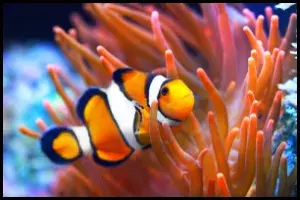
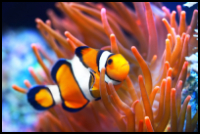
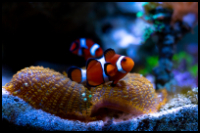
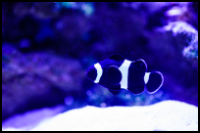

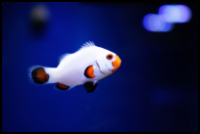
Quick Care Details (Table)
| Livestock Characteristics | Value |
|---|---|
| Care Level | Easy |
| Temperament | Peaceful |
| Diet | Omnivore |
| Maximum Size | 3 Inches |
| Minimum Tank Size | 20 Gallons |
| Reef Compatible | Yes |
| Temperature Range | 72-78F |
| PH Range | 8.1-8.4 |
| DKH Range | 8-12 |
| Salinity Range | 1.020-1.025 |
Species Specific Categories
Helpful Video
Care Details
Aquascape
- Provide plenty of live rock and artificial structures like caves and ledges for the clownfish to explore and seek shelter.
- Include a sea anemone in the setup if possible, as clownfish and anemones have a symbiotic relationship in the wild.
- Create open swimming areas to mimic their natural environment and allow them to move freely.
Substrate
- Use a fine-grain sand substrate to mimic the sandy ocean floor, which is their natural habitat.
- A depth of 1 to 2 inches of substrate is sufficient.
Disease Prevention
- Quarantine new fish before adding them to the main tank to prevent introducing diseases.
- Maintain good water quality through regular testing and appropriate water changes.
- Avoid overstocking the tank to reduce stress on the clownfish and minimize the risk of disease transmission.
Filtration
- Use a reliable filtration system (e.g., hang-on-back, canister, or sump filter) to remove waste and maintain water quality.
- Consider incorporating a protein skimmer to remove organic compounds and help control nutrient levels.
Lighting
- Provide moderate lighting with full-spectrum bulbs to support the growth of any live plants and create a natural day-night cycle.
- Use a timer to ensure consistent lighting periods.
Water Flow
- They prefer moderate water flow in the aquarium, mimicking the gentle currents of their natural habitat.
- Use powerheads or wavemakers to create gentle, irregular water movement.
Hardiness
- Ocellaris are relatively hardy and can adapt to a wide range of water conditions.
- They are a good choice for beginners due to their resilience and ease of care.
- Maintain stable water parameters, including temperature (23-27°C or 73-80°F), pH (8.1-8.4), and salinity (1.020-1.025).
Temperament and Behavior
Behavior and Social Interaction
- Ocellaris Clownfish are generally peaceful and sociable fish.
- They are known to form monogamous pairs, with a dominant female and a smaller male in the group.
- Within their pairs, clownfish exhibit hierarchical social structures.
- They may exhibit territorial behavior, especially around their host anemone or preferred area in the aquarium.
- Ocellaris Clownfish are active and curious, often swimming around and exploring their environment.
- Ocellaris clownfish are generally peaceful but may become territorial towards other clownfish or similar-looking species.
- Clownfish are best keep in male/female pairs
Aggression
- Ocellaris are not overly aggressive, but they can become territorial, especially during breeding or when protecting their eggs.
- They may chase away other fish that venture too close to their territory.
- You can never have more than one female in a aquarium. You may have a hard time telling their gender, but they won’t and will fight until one of them is dead.
- You can have several clownfish, but you must have only one female and keep them in a group of six or more and only have one female.
- When you have a group keep in mind the more clownfish you have the more you can disburse natural aggression.
Breeding Ocellaris
- Ocellaris Clownfish are known to breed in captivity and have a unique breeding process.
- In a pair, the larger fish typically becomes the female, while the smaller one remains the male.
- They lay eggs on a flat surface near their host anemone or in a protected area within the aquarium.
- The male guards and aerates the eggs while the female protects the territory.
Compatibility
- Ocellaris Clownfish are generally compatible with a variety of other fish species, especially those that are not aggressive and won't prey on them.
- They are often kept with other peaceful community fish like gobies, tangs, and certain wrasses.
- Avoid keeping them with large, aggressive fish that may see the clownfish as potential prey or competitors.
Activity Level
- Ocellaris Clownfish have a moderate activity level and spend a lot of time swimming around their territory or exploring their surroundings.
- They may rest near or within their host anemone when they feel secure.
Clean-up Crew
- Ocellaris Clownfish can be considered part of the "clean-up crew" in the aquarium to some extent.
- They are omnivores and will eat a variety of foods, including small crustaceans and algae, helping to control some of the tank's detritus.
- However, they are not as efficient as specialized clean-up crew members like snails or hermit crabs in cleaning algae and detritus.
History, Popularity, History and Species Variety Details
Popularity Ocellaris
The Clownfish Ocellaris is one of the most popular aquarium saltwater fish in the hobby. This is primarily due to the fish being featured in the Pixar movie “Finding Nemo”. The next main reason these fish are so popular is because they are one of the few fish who can form a mutualistic relationship with sea anemones. This is due to their unique slime coat with will make the anemeone’s sting ineffective. The clown fish will also benefit the host by dropping leftover food on top of the anemone. This symbiotic relationship is beneficial for the clownfish because it offers a home safe from predators who don’t want to get stung, and the anemone gets a free meal from time to time.
History of Ocellaris
The first documented scientific description of clownfish occurred in 1850 by French naturalist Achille Valenciennes. He classified two species, Amphiprion percula and Amphiprion ocellaris, which are now commonly known as the orange clownfish and the ocellaris clownfish, respectively. In recent years, taxonomists have conducted extensive research and revised the classification of clownfish species. The family Pomacentridae, which includes clownfish, has undergone significant taxonomic changes, with several species being reclassified and new species being discovered.
Types of Clownfish Ocellaris
- Classic Ocellaris Clownfish: This is the most common and widely recognized form of Ocellaris Clownfish. It has bright orange coloration with three white bands outlined in black on its body.
- Darwin Clownfish: Also known as "Darwin Black" or "Black Ocellaris Clownfish," this variation has a darker overall coloration, with more black on the body and fins. The white bands may appear more muted.
- Midnight Clownfish: Similar to the Darwin variation, the Midnight Ocellaris has darker coloration, with more extensive black markings and slightly muted white bands.
- Platinum Clownfish: The Platinum variation has a unique appearance, featuring a white body with iridescent silver or platinum-like scales. The white bands are still present but may be less distinct.
- Naked Clownfish: This morph lacks the typical white bands seen in most Ocellaris Clownfish. Instead, it may have very faint or no bands, resulting in a more solid orange coloration.
- Picasso Clownfish: Picasso Ocellaris Clownfish exhibit irregular or broken white bands, creating a unique and artistic pattern on their bodies. Each fish's pattern is different, and they are highly sought after by hobbyists.
- Snowflake Clownfish: Snowflake Ocellaris have random white spots scattered across their bodies, which gives them a "snowflake" appearance on top of their typical coloration.
- Wyoming White Clownfish: This variation has a predominantly white body with minimal orange coloration. The white bands are present but may be less visible due to the extensive white coloration.
How to tell the gender for Clownfish Ocellaris
- Observe Size Differences: In most cases, female Ocellaris Clownfish are larger than males. As they mature, females tend to grow slightly larger and more robust compared to the males.
- Watch for Behavior: As they reach maturity, female Ocellaris Clownfish may become more dominant and assertive within the pair. They tend to be the more dominant fish and can exhibit territorial behavior, especially when it comes to protecting their nesting site or eggs.
- Observe the Shape of the Body: In some cases, females may have a slightly rounder or fuller body shape, while males can appear more slender and streamlined.
- Check the Vent Area: The most reliable way to determine the gender of Ocellaris Clownfish is by examining their vent area, located just before the anal fin. Males will have a more pointed vent, while females will have a more rounded and slightly larger vent. However, this method requires careful observation and may be easier with the fish slightly sedated, which should only be done by experienced individuals or veterinarians.
- Observe Breeding Behavior: If you have a pair of Ocellaris Clownfish and they are of breeding age, you may witness courtship and spawning behavior. The male will actively court the female, and they will perform a series of ritualistic behaviors before and during the spawning process.
Breeding Clownfish Ocellaris in the home Aquarium
- Pairing: Start by obtaining a healthy pair of Ocellaris Clownfish. The pair should be sexually mature and compatible. They will usually form a monogamous bond, with the larger fish becoming the female and the smaller one remaining the male.
- Separate Breeding Tank: Set up a separate breeding tank. A tank size of at least 20 gallons (75 liters) is recommended. It should have appropriate hiding spots, like live rock, PVC pipes, or clay pots, where the clownfish can lay their eggs.
- Conditioning: Before attempting breeding, condition the breeding pair with a nutritious diet of live and frozen foods. Providing a balanced diet will promote their health and readiness for breeding.
- Introduce the Pair: Once the clownfish are well-conditioned, introduce them to the breeding tank together. Observe their behavior closely and ensure they are comfortable in their new environment.
- Courtship Behavior: Clownfish engage in elaborate courtship behaviors before spawning. The male will perform dances and movements to attract the female's attention and establish a nesting site.
- Spawning: When the pair is ready to spawn, they will clean the chosen nesting site. The female will lay eggs on a flat surface, often near a protected area, like the live rock or a PVC pipe. The male will then fertilize the eggs by releasing sperm over them.
- Incubation: After spawning, the male will take the primary role in caring for the eggs. He will fan them with his pectoral fins to provide oxygen and protect them from potential threats.
- Hatching: The eggs will typically hatch within 6 to 8 days, depending on water temperature. After hatching, the fry will become free-swimming and start looking for food.
- Feeding Fry: Once the fry are free-swimming, you can offer them small live foods such as rotifers or newly hatched brine shrimp. Gradually transition them to more substantial foods as they grow.
- Grow-Out Tank: As the fry grow, consider moving them to a separate grow-out tank to avoid predation from other tankmates.
Clownfish and Anemone Symbiosis
- Protection from Predators: The primary benefit for the clownfish is protection from predators. Sea anemones have stinging cells called nematocysts on their tentacles, which they use to capture and immobilize prey. These stinging cells are harmful to most fish, but the clownfish have a mucus layer on their skin that protects them from the stings. They can, therefore, live safely within the tentacles of the sea anemone without being harmed.
- Food Source: The clownfish provide the sea anemone with a valuable food source. As they swim around the anemone, they bring food particles and small prey items to the anemone's tentacles. Additionally, the clownfish defecate within the anemone, providing nutrients that the anemone can absorb through its skin.
- Aggressive Defense: The presence of clownfish deters some potential predators of the sea anemone. Clownfish are territorial and will aggressively defend their host anemone against intruders, including other fish that may try to eat the anemone or its tentacles.
- Luring Prey: Some species of clownfish, such as the Ocellaris Clownfish, have been observed luring prey closer to their host anemone. They do this by engaging in "dance" behaviors that attract other fish towards the anemone. Once the prey gets too close, the sea anemone captures it with its stinging tentacles.
- Nesting Site: Sea anemones provide a safe and protected nesting site for clownfish to lay their eggs. The clownfish carefully clean and defend the anemone's surface where they will deposit their eggs, and the anemone provides a secure environment for the eggs to develop.
Ocellaris Clownfish (Amphiprion ocellaris)
- Has narrow black borders on its white stripes.
- Generally more peaceful and suitable for community aquariums.
- Usually grows up to 3 inches (7.5 cm).
- Popular choice for beginner aquarists.
Percula Clownfish (Amphiprion percula)
- Percula clowfish have wider black borders on its white stripes.
- Percula clowfish More territorial and aggressive than ocellaris.
- Usually grows up to 3.2 inches (8 cm).
- Percula clowfish have more Feisty and bold behavior, fascinating to watch.
Other
This is one of the hardiest fish in the hobby, often used for a “Fish in Cycle” because they often will survive low levels of ammonia and nitrite. They have an extremely thick slime coat making them more resistant to parasites like Fluke, Ich and Velvet than most other fish would naturally be. Please keep in mind they are still able to get the parasite and possibly die from the infection. Even though clownfish are hardy they do have a disease that commonly infect them called Brooklynella. It is so common in clownfish that the disease has been nicknamed “Clownfish Disease”.
Frequently Asked Questions
Do Ocellaris Clownfish require anemones to survive?
No, Ocellaris Clownfish do not require anemones to survive in captivity. They can thrive and live happily in a well-maintained aquarium without anemones. However, they may form a symbiotic relationship with certain species of anemones in the wild.
Are Ocellaris Clownfish reef-safe?
Ocellaris Clownfish are generally considered reef-safe, meaning they can coexist with corals and other invertebrates in a reef aquarium. However, caution should be exercised with some delicate or stinging corals as the clownfish may host them or potentially cause minor damage.
Can I keep Ocellaris Clownfish in pairs or groups?
Ocellaris Clownfish can be kept individually, or in male/female pairs. You should never have more than one female in the aquarium, because they are extremely territorial and will fight it out until one of them dies. Also note that if you want to keep more than a mated pair you should make the group 6 or more with only one female Clownfish. Having groups of 3 or 4 doesn’t work out well long term because these fish are territorial to their own kind and having only a few Clownfish won’t spread the aggression enough. The bigger the harem is the more you can spread aggression, so you can avoid any single Ocellaris from being ganged up on and singled out.
What should I feed Ocellaris Clownfish?
Ocellaris Clownfish are omnivorous. They should be fed a varied diet consisting of high-quality marine pellets or flakes, frozen or live foods like brine shrimp, mysis shrimp, and chopped seafood. It's recommended to feed them small amounts multiple times a day.
How big do Ocellaris Clownfish get?
Ocellaris Clownfish are relatively small, growing up to 3-4 inches (7-10 cm) in length. The females tend to be slightly larger than the males.
What tank size is suitable for Ocellaris Clownfish?
For a single Ocellaris Clownfish, an aquarium size of at least 20 gallons is typically recommended. If keeping multiple clownfish, it's advisable to provide more space, such as a 30-gallon aquarium or larger, but it is commonly found to have a mated pair survive in a 20 gallon saltwater aquarium.
Can Ocellaris Clownfish change their gender?
Clownfish have a unique ability known as protandrous hermaphroditism, where they can change their gender. In a group, the largest fish is typically female, the second-largest is male, and the others remain juvenile. If the female dies or is removed, the male can change its gender to become the dominant female.
Can Ocellaris Clownfish be kept with other fish species?
Ocellaris Clownfish can be compatible with a variety of peaceful fish species that are not aggressive or overly territorial. However, compatibility can vary depending on individual fish personalities and tank setup. It's important to research the specific species you plan to keep with them to ensure compatibility.
Do Ocellaris Clownfish need a specific water flow in the aquarium?
Ocellaris Clownfish prefer gentle to moderate water flow in the aquarium. They are adapted to reef environments with moderate water movement. A combination of water circulation from filtration systems and strategically placed powerheads or wavemakers can provide suitable water flow.
Can Ocellaris Clownfish jump out of the aquarium?
Ocellaris Clownfish have been known to jump out of uncovered tanks. It's important to have a secure lid or cover on the aquarium to prevent them from escaping. Providing sufficient water depth and creating a barrier above the water surface can also help prevent jumping incidents.
Can Ocellaris Clownfish change their colors?
Ocellaris Clownfish can exhibit variations in coloration, but they do not change their colors dramatically. However, they may show temporary changes in coloration due to stress, aggression, or environmental factors.

